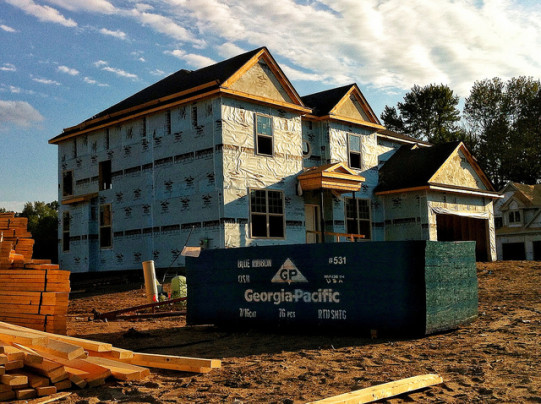Realtors know their local real estate market better than anybody. Because of this, the National Association of Realtors conducts a monthly survey of real estate professionals to gauge the current market and the outlook for the future. According to April’s survey, housing market activity is up slightly from one year ago, though many of the fundamentals remain virtually unchanged. Realtors are reporting high levels of demand from buyers but say sales are being held back due to a lack of for-sale inventory, which is also putting upward pressure on home prices in some areas. Despite increasing prices, however, home sales have been improving. In fact, recent sales data shows new and existing home sales both up from one month earlier. Additionally, most economists expect the housing market and economy to continue to improve after a slow first quarter. Still, affordability concerns may be keeping some potential first-time buyers from entering the market. For example, first timers accounted for just 32 percent of sales in April. Historically, first purchases have been closer to 40 percent of total sales. Realtors, however, remain confident in the outlook for the next six months. Summer is typically a busy season and, with help from a seasonal uptick in the number of homes available for sale, conditions should be favorable for prospective home buyers. More here.
Archive for May 2016
Pending Home Sales Soar To 10-Year High
The National Association of Realtors’ Pending Home Sales Index measures the number of contracts to buy homes that are signed in any given month. The index is considered a good predictor of future home sales because it tracks signings not closings, which take place roughly a month later. In April, pending sales were up 5.1 percent and reached their highest level since February of 2006. Lawrence Yun, NAR’s chief economist, said demand has exceeded expectations so far this spring. “The ability to sign a contract on a home is slightly exceeding expectations this spring even with the affordability stresses and inventory squeezes affecting buyers in a number of markets,” Yun said. “The building momentum from the over 14 million jobs created since 2010 and the prospect of facing higher rents and mortgage rates down the road appear to be bringing more interested buyers into the market.” Markets in the South and West were particularly strong in April, with both seeing double-digit increases over the month before. Overall, the number of signed contracts to buy homes was 4.6 percent higher than it was at the same time last year. More here.
Demand For Home Purchase Loans Rises
According to the Mortgage Bankers Association’s Weekly Applications Survey, the number of Americans who requested applications for loans to buy homes rose 5 percent last week. The improvement puts demand for home purchase loans 17 percent higher than it was at the same time one year ago. Lynn Fisher, MBA’s vice president of research and economics, told CNBC purchase application demand rebounded last week after a slight lull. “Purchase applications got back on track last week, resuming the level of activity observed throughout most of April and May,” Fisher said. On the other hand, refinance demand was relatively flat – mostly due to a slight rise in average mortgage rates. In fact, rates were up across all loan categories, including 30-year fixed-rate loans with both conforming and jumbo balances, loans backed by the Federal Housing Administration, and 15-year fixed-rate loans. Also in the report, the average home purchase loan hit an all-time survey high of $307,700. This reflects a lack of homes available for sale at the lower end of the market. Since there are more high-end homes for sale this spring, the average loan size has climbed. The MBA’s weekly survey has been conducted since 1990 and covers 75 percent of all retail residential mortgage applications. More here.
New Home Sales Post Biggest Gain Since ’92
Sales of newly built, single-family homes rose 16.6 percent in April, according to new estimates released by the U.S. Census Bureau and the Department of Housing and Urban Development. The gain was the largest month-over-month increase since 1992 and puts new home sales nearly 24 percent higher than they were last year at this time. Combined with rising housing starts, building permits, and sales of previously owned homes, the improvement is another sign that the housing market and economy are gaining strength. And, though economists expected new home sales to increase in April, the actual numbers far exceeded their predictions. In fact, economists polled by Reuters forecast sales rising to a 523,000 unit-rate, while the official estimate came in at 619,000. Regionally, the South, West, and Northeast saw dramatic double-digit increases over the previous month. The Midwest, on the other hand, experienced a 4.8 percent drop in sales. The report also included news that the median price for a new home set a new record at $321,100, up 9.7 percent from last year. More here.
Are Low Credit Scores Discouraging Buyers?
A recent review of home loan activity conducted by CoreLogic reveals a significant difference between the average loan applicant today compared with 10 years ago. The analysis looked at possible reasons loan originations have dropped over the past decade. Tighter credit standards are often blamed for keeping potential buyers from entering the housing market. But – though credit availability is tighter today than it was before the financial crisis and recession – there hasn’t been an equivalent increase in the number of applicants who have been denied loans. This indicates that, though credit standards have been raised, they may not be the only reason loan originations have dropped. In fact, CoreLogic’s analysis found that the average borrower credit score last year was nearly 750, while it was closer to 700 in 2005. The fact that average credit scores have increased could point to a drop in the number of loan applications from buyers with lower scores. If potential buyers are being discouraged from applying for a loan because their credit score isn’t optimal, it could be contributing to the overall drop in originations. It also means that loosening credit standards may not be the key to unlocking mortgage demand. Instead, consumers may need to be better informed about lending standards and how to check, correct, and maintain a good credit score. More here.
Sales Of Existing Homes Up In April
Sales of previously owned homes rose for the second-consecutive month, according to new numbers released by the National Association of Realtors. In April, existing-home sales – which includes single-family homes, townhomes, condominiums, and co-ops – increased 1.7 percent, beating economists’ expectations and pushing sales 6 percent above last year’s level. Lawrence Yun, NAR’s chief economist, said April’s increase is a sign that the housing market is slowly building momentum. “Primarily driven by a convincing jump in the Midwest, where home prices are most affordable, sales activity overall was at a healthy pace last month as very low mortgage rates and modest seasonal inventory gains encouraged more households to search for and close on a home,” Yun said. “Except for in the West – where supply shortages and stark price growth are hampering buyers the most – sales are meaningfully higher than a year ago in much of the country.” A look at regional results shows the South and West both down slightly from the month before, while the Northeast posted a 2.8 percent improvement and the Midwest surged 12.1 percent. Also in the report, the number of homes available for sale rose 9.2 percent. More here.
Spring Rebound To Follow Slow 1st Quarter
Much like last year, the first quarter of 2016 was slower than expected. Both the housing market and broader economy showed weakness amid harsh winter weather and global economic uncertainty. But also like last year, Fannie Mae’s Economic & Strategic Research Group says economic growth should rebound in the spring and continue to grow through the remainder of the year. Doug Duncan, Fannie Mae’s chief economist, says an uptick in hours worked and average hourly earnings should help support consumer spending, which will help boost the economy. He also expects home sales to climb. “Home sales are expected to pick up heading into the spring season amid the backdrop of declining mortgage rates, rising pending home sales and purchase mortgage applications, and continued easing of lending standards on residential mortgage loans,” Duncan said. “Meanwhile, the homeownership rate showed signs of stabilizing during the first quarter of this year, as the relatively high homeownership rates among Baby Boomers have helped offset low homeownership rates among Millennials, many of whom remain on the sidelines due to ongoing affordability issues.” More here.







